余若薇去信 批認同李指控 馬斐森:被圍想起希斯堡慘劇
【明報專訊】港大校務委員會主席李國章上周四開記者會指公民黨向學生「供毒」,又稱去年7月圍堵校委會事件中,該黨黨魁梁家傑及主席余若薇均在場,上周圍堵時余亦在場。余若薇前晚向港大校長馬斐森發公開信,不滿他在同一記者會上稱,「若李教授告訴你誰在場,你應相信他的判斷」,余指馬斐森是認同李國章的誹謗式指控,否則最少也與之有關連(associated with),余對此感到失望。
馬斐森回覆:沒表達立場
余在公開信稱,去年7月圍堵事件,她是以校友身分捍衛院校自主,而上周二圍堵校委會當天,她傍晚5時便離開,沒跟學生談話,事後看新聞才知圍堵事件,當天梁家傑亦不在場。她說,批評學生遭荼毒或指他們是暴民,只會推他們進死角,希望校長可引領學生走過風暴,相信很多中間人可助重建信任及和諧。在記者會當日曾指各方就港大事件表態不是干預校政的馬斐森,昨回覆余稱不會評論李國章的言論,應留待李找理據解釋(justify),他沒表達立場(have not taken sides),他最重視的是安全,「關於誰有沒有操控那件事,是枝節(sideshows)」。他堅持譴責學生的行動危害安全,因周二晚被困人群中時,他很難才能站穩,當時想起1989年導致96名球迷死亡的英國希斯堡人踩人慘劇(Hillsborough disaster),確想到有可能出現傷亡。
余昨回信,稱面對胡亂指控,即使馬斐森不道歉,亦期望他會解釋,惟現在什麼都沒有做。她又以希斯堡慘劇為例,指是警方醞釀出爆發慘劇的處境,希望校方也找出圍堵事件的源頭。
Hillsborough disaster and its aftermath
- 19 December 2012
- England
Although it remains the name of the ground of one of England's famous old football clubs, since 1989 the word Hillsborough has more strongly evoked Britain's worst sporting disaster.
On 15 April 1989, at the start of an FA Cup semi-final, a crush on the steel-fenced terraces of Sheffield Wednesday's stadium resulted in the death of 96 Liverpool fans and left hundreds more injured.
The inquiry into the disaster, led by Lord Justice Taylor, established the main cause as a failure of police crowd control.
Events began to unfold from around 14:30 BST. The game was to be a repeat of the 1988 semi-final, in which Liverpool had faced Nottingham Forest at the same venue.
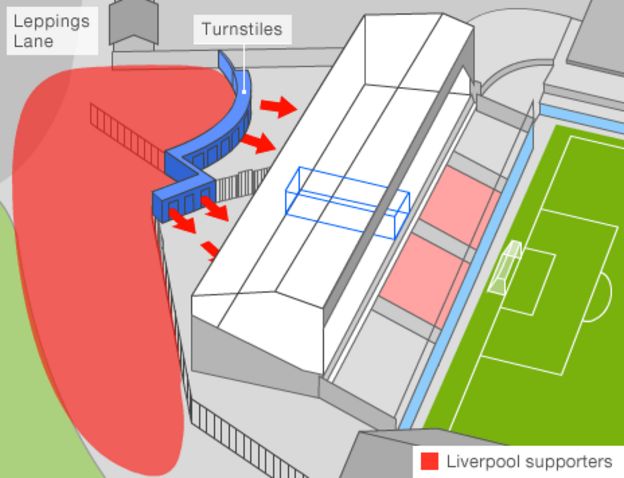

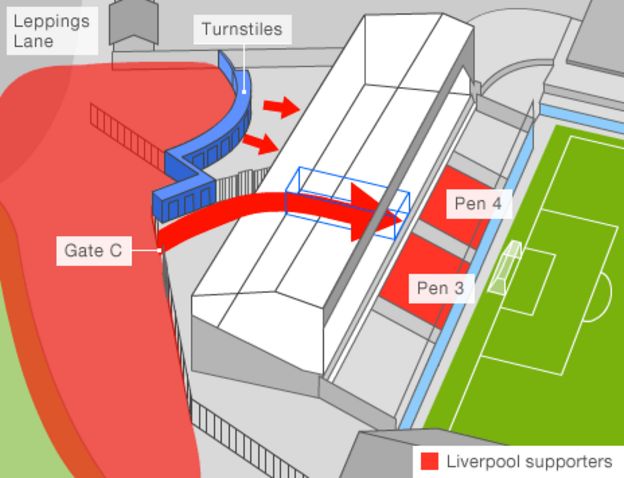
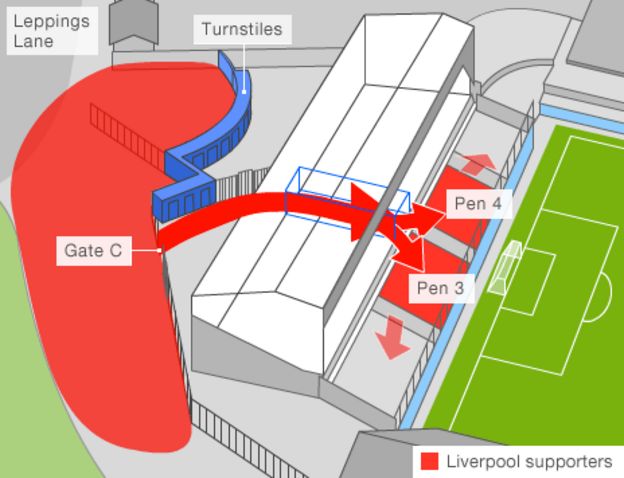
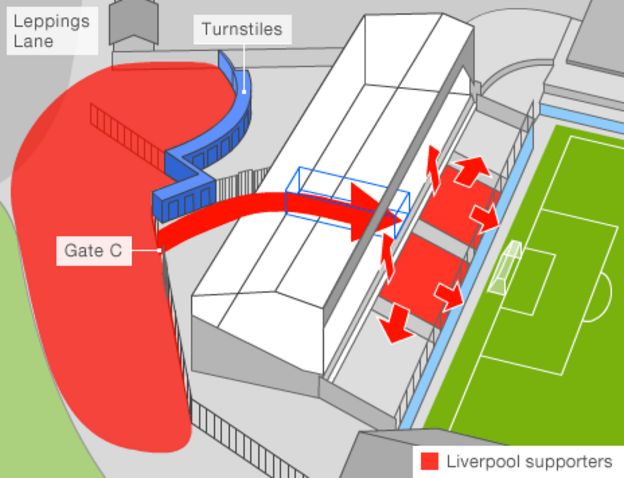

Liverpool fans had begun arriving at the ground from midday, but had to enter their designated stand at Leppings Lane through a small number of decrepit turnstiles.
Once inside, many made their way on to the terraced lower stand which was ringed with blue-painted steel fences and laterally divided into "pens".
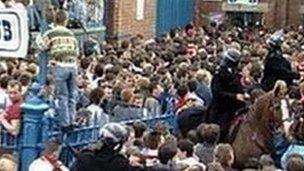
Fencing had been put up by many football clubs during the 1970s and 80s to control crowds and prevent pitch invasions.
By about 14:50, pens 3 and 4 - those directly behind the goal - were full, but outside the ground thousands of fans were still waiting to get in.
The pens' official combined capacity was 2,200. It was later discovered this should have been reduced to 1,600 as crush barriers installed three years earlier did not meet official safety standards.
At 14:52, police ordered a large exit gate - Gate C - to be opened to alleviate the crush outside the ground. Around 2,000 fans then made their way into the ground and headed straight for a tunnel leading directly to pens 3 and 4.
This influx caused severe crushing in the pens. Fans began climbing over side fences into the relatively less packed adjoining pens to escape.
Makeshift stretchers
It was later estimated that more than 3,000 supporters were admitted to the central pens - almost double the "safe" capacity.
At 15:00, the game kicked off. Five minutes later a crush barrier in pen 3 gave way, causing people to fall on top of each other.
Supporters continued to climb perimeter fences to escape, while others were dragged to safety by fans in the upper tiers.
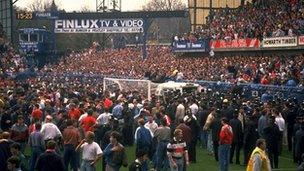
At 15:06, a policeman ran on to the pitch and ordered the referee to stop the game. In the chaotic aftermath, supporters tore up advertising hoardings to use as makeshift stretchers and tried to administer first aid to the injured.
The authorities' response to the disaster was slow and badly co-ordinated.
Firefighters with cutting gear had difficulty getting into the ground, and although dozens of ambulances were dispatched, access to the pitch was delayed because police were reporting "crowd trouble".
Of the 96 people who died, only 14 were ever admitted to hospital.
Four days after the disaster, the Sun newspaper published a story under the headline The Truth, and claimed that fans had picked the pockets of victims, and attacked and urinated on police and rescue workers.
The story provoked an intense backlash, with the newspaper boycotted by most newsagents in Liverpool.
In his interim report on 4 August 1989, Lord Justice Taylor wrote that the key element of police control at fault was the failure to close off the tunnel leading to pens 3 and 4 once Gate C had been opened.
He went on to criticise police for their failure to handle the build-up of fans outside the ground properly, and their slow reaction to the unfolding disaster.
Some of his strongest words were reserved for the police commander, Ch Supt David Duckenfield, for "failing to take effective control", and South Yorkshire Police who attempted to blame supporters arriving at the ground "late and drunk".
'Accidental death'
Despite the Taylor Report, which was also critical of Sheffield Wednesday Football Club and Sheffield City Council, on 14 August 1990 the director of public prosecutions decided not to bring criminal charges against any individual, group or body on the grounds of insufficient evidence.
Inquests in 1991 into the deaths of the victims returned a majority verdict of accidental death.
Coroner Dr Stefan Popper limited the scope of the inquests to events up to 15:15, on the grounds that all the victims were either dead or brain dead by this time.
However, this meant that the response of the police and ambulance services after 15:15 could not be properly examined.
Many families disputed his findings and began to campaign for a fresh inquiry.
In July 1991 the Police Complaints Authority recommended that Ch Supt Duckenfield and his assistant, Supt Bernard Murray, should face disciplinary charges. However, Ch Supt Duckenfield retired on medical grounds and the case against Supt Murray was eventually dropped.
In the wake of renewed public and media interest in the disaster, which followed the broadcast of Jimmy McGovern's documentary-drama Hillsborough in 1996, Home Secretary Jack Straw ordered a "scrutiny of evidence".
Lord Justice Stuart-Smith was appointed to review "new" evidence which had not been submitted to the inquiry or inquests and also dozens of police and witness statements, apparently critical of police, which had been altered.
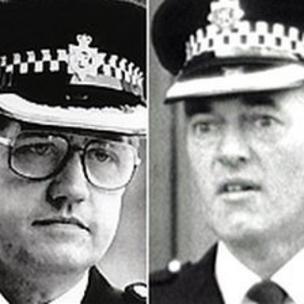
Lord Justice Stuart-Smith's conclusion was that the fresh evidence did not add anything significant to the understanding of the disaster, and that while statements should not have been edited, this was simply an "error of judgement".
Jack Straw accepted the findings and ruled out a new inquiry, but in August 1998 the Hillsborough Family Support Group brought charges of manslaughter against David Duckenfield and his deputy, Supt Bernard Murray, in a private prosecution.
The case came to trial in 2000. After six weeks the jury found Mr Murray not guilty of manslaughter and said it could not reach a verdict on Mr Duckenfield.
The judge, Mr Justice Hooper, ruled out a majority verdict and refused a retrial on the grounds that Mr Duckenfield had faced public humiliation and a fair trial would be impossible.
In 2006, Anne Williams, the mother of 15-year-old victim Kevin Williams, took a case to the European Court of Human Rights challenging the verdict of the original inquest.
She claims her son was still alive at 16:00 on the day of the disaster and did not die from traumatic asphyxia.
The court rejected the case in March 2009 on the grounds that the time period for her challenge had expired.
Lingering suspicion
As the 20th anniversary passed, campaigners including the Hillsborough Family Support Group continued to press for the release of the full facts about the disaster, amid lingering suspicion that some details had been withheld.
In April 2009, the then Home Secretary Jacqui Smith requested South Yorkshire Police to release secret files containing detailed evidence.
In December that year, the Hillsborough Independent Panel was set up by Home Secretary Alan Johnson to oversee a "full public disclosure of relevant government and local information".
Delivering its report in September 2012, the panel found that police had deliberately altered more than 160 witness statements in an attempt to blame Liverpool fans for the fatal crush.
It found that crowd safety was "compromised at every level" and that 41 of the 96 who died could have survived, prompting calls for fresh inquests.
The panel also found that the source of the Sun newspaper story was a "local Sheffield press agency informed by several SYP officers, an SYP Police Federation spokesperson and a local MP (Sir Irvine Patnick)".
The disclosures prompted apologies from Prime Minister David Cameron and former Sun editor Kelvin Mackenzie, and calls for a criminal investigation into the police handling of the disaster.
In December 2012 the High Court quashed the original inquest verdicts, and Home Secretary Teresa May ordered a fresh police inquiry into the disaster.
沒有留言:
張貼留言